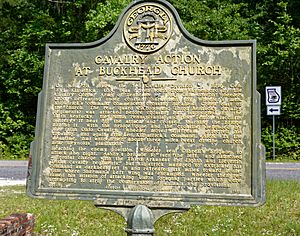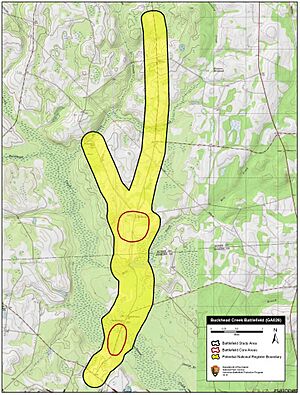Battle of Buck Head Creek facts for kids
Quick facts for kids Battle of Buck Head Creek |
|||||||
|---|---|---|---|---|---|---|---|
| Part of the American Civil War | |||||||
 Historical marker |
|||||||
|
|||||||
| Belligerents | |||||||
| Commanders and leaders | |||||||
| Hugh Judson Kilpatrick | Joseph Wheeler | ||||||
| Units involved | |||||||
| 3rd Cavalry Division, Military Division of the Mississippi | Department of South Carolina Department of Georgia Department of Florida |
||||||
| Strength | |||||||
| 5,000 | 2,000 | ||||||
| Casualties and losses | |||||||
| 46 | 600 | ||||||
The Battle of Buck Head Creek was a fight during the American Civil War. It happened on November 28, 1864. This battle was part of Sherman's March to the Sea. This was a big military movement by the Union Army through Georgia.
During the battle, Union cavalry soldiers fought against Confederate cavalry. The Union forces were led by Hugh Judson Kilpatrick. The Confederate forces were led by Joseph Wheeler. The Union soldiers stopped the Confederate attack. However, the Union cavalry could not complete their original goals. These goals included destroying railroad tracks and freeing Union prisoners of war.
The Battle Begins
On November 26, 1864, Confederate General Wheeler found two Union regiments. These regiments were moving slower than the main Union force. Wheeler attacked their camp. He chased them towards the larger Union group. This stopped the Union plan to destroy a railroad bridge called the Briar Creek trestle. Instead, the Union soldiers destroyed about a mile of track in the area.
Union General Kilpatrick then found out something important. The Union prisoners at Camp Lawton had been moved. They were taken to other places that were unknown. Because of this, Kilpatrick decided to move his troops. He wanted to join up with General William Tecumseh Sherman's main army.
Fighting at the Creek
Kilpatrick's soldiers set up camp near Buck Head Creek on the night of November 27. The next morning, General Wheeler's Confederate troops arrived. They almost captured Kilpatrick himself. Wheeler's men chased Kilpatrick and his soldiers towards Buck Head Creek.
As the main Union force crossed the creek, a special group stayed behind. This was the 5th Ohio Cavalry regiment. They were led by Colonel Thomas T. Heath. They also had two cannons. This group fought a "rearguard action." This means they fought from behind a barrier of fence rails. They fired their cannons, using "canister fire." This type of shot was like a giant shotgun blast. It caused a lot of damage to Wheeler's soldiers. After fighting, the Union soldiers burned the bridge behind them. This made it harder for the Confederates to follow.
Wheeler's troops soon crossed the creek anyway. They continued to follow the Union soldiers. But another Union group was waiting. They had built barricades at a place called Reynolds' Plantation. This group stopped the Confederate attack. Eventually, the Confederates had to retreat. Kilpatrick and his men then rode on to rejoin General Sherman's army. They met up near Louisville, Georgia.
What Happened Next
The Union army reported that 46 of their soldiers were hurt or killed. General Kilpatrick thought that about 600 Confederate soldiers were hurt or killed. However, General Wheeler reported a lower number, around 70 casualties. Among the Confederate casualties was General Felix Huston Robertson. He was badly wounded in his elbow.


